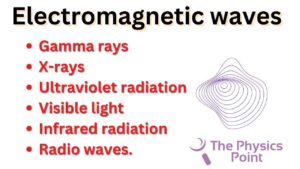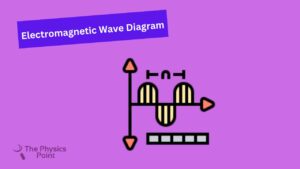What is Electromagnetic Spectrum? Definition, Examples and Uses

Hello, you are very welcome to our physics website in today’s article what is electromagnetic spectrum, we will give you a depth knowledge about spectrums and Waves. there are numbers of waves around us that we cannot see, but we can detect with the help of Advanced devices. teach babes helps us in many days such as in communication in medical field line etc. electromagnetic waves are the very major character of modern-age communication. So you have to read this article from start to end to avoid any type of doubt. This article consists of full of depth knowledge about the electromagnetic radiation and its parts
This is very important from the exam point of view. Many related questions (What is Electromagnetic Spectrum) were asked in the examination. These questions can be in the form of such as What is Electromagnetic Spectrum, electromagnetic spectrum, electromagnetic spectrum wavelengths, electromagnetic spectrum definition, and electromagnetic spectrum chart. For the electromagnetic spectrum activity pdf or properties of electromagnetic spectrum pdf, read the article very carefully. Let’s start our today’s topic what is electromagnetic spectrum?
What is Electromagnetic Spectrum (Definition)?
The electromagnetic spectrum is a wide range of series of frequency, wavelength, and photon energy, covering frequencies from below 1 hertz to above 1025 Hertz concerning the wavelength which is a few kilometers to a fraction of size. you must know that electromagnetic waves have the speed of light in a vacuum. It means that electromagnetic waves travel in a vacuum they travel with the speed of light is 3 x 108.
In the electromagnetic spectrum, different types of waves are represented by different kinds of subranges which are generally known as portions. These portions can be visible light, infrared or ultraviolet radiation.
Type of waves in the electromagnetic spectrum
In our article what is electromagnetic spectrum, no we are going to tell you about the different types of waves that an electromagnetic spectrum consists of. radio waves infrared radiation ultraviolet radiation. There is the table (Electromagnetic spectrum chart) given below that will tell you everything about these days and their frequency and also wavelength ranges. With the help of this given table, you are able to compare electromagnetic waves in respect of frequency and wavelength.
| Type of Radiations | Frequency Range in Hz | Wavelength Range |
| Gamma-rays (Least wavelength) | 1020 – 1024 | < 10-12 m |
| X-rays | 1017 – 1020 | 1 nm – 1 pm |
| Ultraviolet | 1015 – 1017 | 400 nm – 1 nm |
| Visible (Ray of Vision) | 4 x 1014 – 7.5 x 1014 | 750 nm – 400 nm |
| Near-infrared | 1 x 1014 – 4 x1014 | 2.5 μm – 750 nm |
| Infrared radiation | 1013 – 1014 | 25 μm – 2.5 μm |
| Microwaves radiation | 3 x 1011 – 1013 | 1 mm – 25 μm |
| Radio waves (maximum wavelength) | < 3 x 1011 | > 1 mm |
Examples and Uses Of Electromagnetic Waves
1. X-Rays
These races are nowadays used in many fields. in medical lines, doctors also use this Ray to take out an image of a bone or teeth inside the body which is called an x-ray graphic. the airport security system also consists of an X-Ray metal detector, which is used to see through the bags and check out if there is any unallowed material present or not. X-rays are generated also by the warm gases in the universe.
2. Gamma rays
These are also used in the medical field in a wide range. These rays are used to see the inside image of our bodies and the generation of gamma rays in our universe is the biggest.
3. Ultraviolet
The Sun is the main source of this type of radiation i.e. ultraviolet radiation. ultraviolet radiation causes cancer and skin-related disease and also snow blindness. The hot things that are present in space can also emit UV radiation. These rays can also increase chemical sensitivity and produced carcinogen effects in the skin. Alternation of the immune system is also seen in the case of ultraviolet radiation exposure.
4. Visible
This is the only light that can be detected with the help of our eyes. the bulb stars electric lights all emit the visible light spectrum. Without a visible light spectrum, we cannot see our surroundings and object.
5. Microwave
The microwave oven is used in our kitchens on the basis emit microwave radiation the radiation is also used by astronomers to detect and determine the structure of the nearby Galaxy and the nearby stars.
6. Radio waves
These waves can be emitted by gases and the stars in space. these radio waves are generally used for communication such as TV and mobile. you should know that the radio which we listen is basically captured these types of radio waves transmitted by the Radio stations. These waves have the largest wavelength among all electromagnetic waves.
7. Infrared radiation
The goggles or specs that are used for night vision, use the concept of infrared. infrared radiation emitted by the hot object and the steps of devices can detect and read the infrared light emitted by any source. In space, these infrared light radiations help to detect interstellar dust.

Frequently Asked Questions (FAQs)
Ques. Which of the electromagnetic spectrum has the highest value of wavelength?
Ans. radio waves have the highest value of wavelength and it has the lowest frequency. So we can say that they have the minimum energy among all electromagnetic waves.
Ques. Which electromagnetic wave carries the least energy?
Ans. Radio waves carry the list energy because these waves have the lowest frequency.
Ques. What is the wavelength spectrum of visible light?
Ans. The visual light lies in the range of the EMW spectrum between the infrared and the ultraviolet rays. In terms of frequency, it lies about 4 × 1014 to 8 × 1014 hertz and has a wavelength of about seven hundred forty nanometers ( 2.9 × 10−5 inches) to Three hundred eighty nanometers that are around 1.5 × 10−5 inches.
Conclusion
Guys, in today’s article. What is electromagnetic spectrum be learned about many things such as a diagram of the electromagnetic spectrum, electromagnetic spectrum frequency, electromagnetic spectrum examples, electromagnetic spectrum in nm, uses of electromagnetic spectrum, etc. if you want to give any suggestions related to this article you can also contact us, we welcome your suggestions. Stay tuned with us. We will again meet with a new physics article on the next day.

